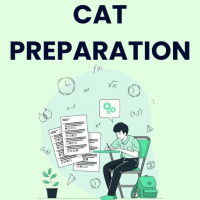CAT Exam > CAT Questions > ___________ (he / buy)the new house by Octobe...
Start Learning for Free
___________ (he / buy) the new house by October?
Correct answer is 'Will he have bought'. Can you explain this answer?
Most Upvoted Answer
___________ (he / buy)the new house by October?Correct answer is 'Will...
Explanation of the answer:
The given sentence is in the future perfect tense, which is used to talk about an action that will be completed by a certain point in the future. It is formed by using the auxiliary verb "will" + "have" + past participle of the verb.
Here, the action is "buying the new house" and the point in the future is "October". So, the correct answer is "will he have bought".
Breakdown of the sentence:
- Subject: he
- Auxiliary verb: will
- Main verb: have bought
- Object: the new house
Conclusion:
In conclusion, the correct answer for the given sentence is "Will he have bought the new house by October?" This question belongs to the CAT category, which is a competitive exam for admission into management programs in India.

|
Explore Courses for CAT exam
|

|
Question Description
___________ (he / buy)the new house by October?Correct answer is 'Will he have bought'. Can you explain this answer? for CAT 2025 is part of CAT preparation. The Question and answers have been prepared according to the CAT exam syllabus. Information about ___________ (he / buy)the new house by October?Correct answer is 'Will he have bought'. Can you explain this answer? covers all topics & solutions for CAT 2025 Exam. Find important definitions, questions, meanings, examples, exercises and tests below for ___________ (he / buy)the new house by October?Correct answer is 'Will he have bought'. Can you explain this answer?.
___________ (he / buy)the new house by October?Correct answer is 'Will he have bought'. Can you explain this answer? for CAT 2025 is part of CAT preparation. The Question and answers have been prepared according to the CAT exam syllabus. Information about ___________ (he / buy)the new house by October?Correct answer is 'Will he have bought'. Can you explain this answer? covers all topics & solutions for CAT 2025 Exam. Find important definitions, questions, meanings, examples, exercises and tests below for ___________ (he / buy)the new house by October?Correct answer is 'Will he have bought'. Can you explain this answer?.
Solutions for ___________ (he / buy)the new house by October?Correct answer is 'Will he have bought'. Can you explain this answer? in English & in Hindi are available as part of our courses for CAT.
Download more important topics, notes, lectures and mock test series for CAT Exam by signing up for free.
Here you can find the meaning of ___________ (he / buy)the new house by October?Correct answer is 'Will he have bought'. Can you explain this answer? defined & explained in the simplest way possible. Besides giving the explanation of
___________ (he / buy)the new house by October?Correct answer is 'Will he have bought'. Can you explain this answer?, a detailed solution for ___________ (he / buy)the new house by October?Correct answer is 'Will he have bought'. Can you explain this answer? has been provided alongside types of ___________ (he / buy)the new house by October?Correct answer is 'Will he have bought'. Can you explain this answer? theory, EduRev gives you an
ample number of questions to practice ___________ (he / buy)the new house by October?Correct answer is 'Will he have bought'. Can you explain this answer? tests, examples and also practice CAT tests.

|
Explore Courses for CAT exam
|

|
Signup for Free!
Signup to see your scores go up within 7 days! Learn & Practice with 1000+ FREE Notes, Videos & Tests.


















